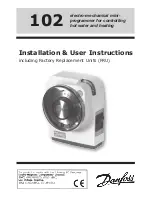
NQ2 Series Electromagnetic Starter
04
2) Inspection of operating flexibility of the thermal relay inside the starter
Open the cover of the thermal relay. Press the blue Reset button using a small screwdriver and rotate it
90° clockwise so that the relay is in the Automatic Reset status (Letter A on the Reset button is in vertical
alignment with the reference point). Then, use the small screwdriver to press the red Test button beside
TEST downward vertically. You can hear the operating sound of the contact, and the indicator column is
red. Loosen your hold on the screwdriver, you can hear the sound of the reset contact and the indicator
column resumes its original status (Alternatively, you can use a multimeter). If any abonormality occurs
during the testing, replace it immediately. The panel layout of the thermal relay is shown in Fig. 5.
Current dial
Indicator
column
Cover
Stop
button
Reset
button
Test
button
2
/
T1
98
97
96
95
NC
NO
4
/
T2
6
/
T3
Reference
point
Manual
reset
Automatic reset
Figure 5 Panel layout of the thermal relay
3) Starter wiring diagram
When the product leaves the factory, the control circuits are wired on the premises that the voltage of
the starter is the same as that of the main circuit. Once the main circuit is powered on, the starter can
operate without additional wiring. The starter cannot control single-phase motor unless the main circuits of
any two of its phases are connected in series. In case the control circuit voltage is different from the main
circuit voltage, disconnect the two wires on the main circuit and connect them to the control power supply.
See Fig. 6 – Fig. 9 for the starter wiring diagram.
Figure 6 Control circuit voltage same as
main circuit voltage (three-phase)
Figure 7 Control circuit voltage different from
main circuit voltage (three-phase)
L1 L3 L5
FU1
1
3 5
2
4
6
1
3 5
2
4
6
U V W
M
3~
KM
FR
KM
FR
95
96
A1
A2
13
14
KM
L1 L3 L5
FU1
1
3 5
2
4
6
1
3 5
2
4
6
U V W
M
3~
KM
FR
KM
FR
95
96
A1
A2
13
14
KM
additional power supply




























